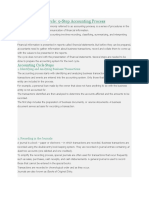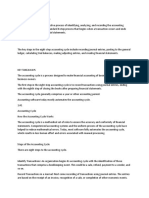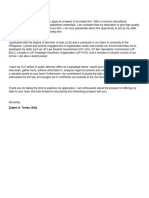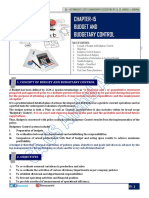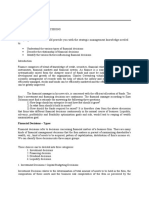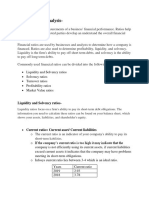Accounting Cycle
Accounting Cycle
Uploaded by
Ma. Aizey TorresCopyright:
Available Formats
Accounting Cycle
Accounting Cycle
Uploaded by
Ma. Aizey TorresOriginal Title
Copyright
Available Formats
Share this document
Did you find this document useful?
Is this content inappropriate?
Copyright:
Available Formats
Accounting Cycle
Accounting Cycle
Uploaded by
Ma. Aizey TorresCopyright:
Available Formats
Journal Entries
Accounting Cycle
Identify your transactions.
A business starts its accounting cycle by identifying and gathering details about the
transactions during the accounting period. When identifying a transaction, you’ll need
to determine its impact. Transactions include expenses, asset acquisition, borrowing,
debt payments, debts acquired and sales revenues.
Record the transactions.
The next step is to record your financial transactions as journal entries in your
accounting software or ledger. Some companies use point-of-sale technology linked
with their books, combining steps one and two. Still, it’s essential for businesses to
keep track of their expenses.
Your accounting type and method determine when you identify expenses and income.
For accrual accounting, you’ll identify financial transactions when they are incurred.
Cash accounting, on the other hand, involves looking for transactions whenever cash
changes hands.
Double-entry accounting suggests recording every transaction as a credit or debit in
separate journals to maintain a proper balance sheet, cash flow statement and income
statement. On the other hand, single-entry accounting is more like managing a
checkbook. It doesn’t require multiple entries but instead gives a balance report.
Post your transactions to a ledger.
Once transactions are recorded in journals, they are also posted to the general ledger.
A general ledger is a critical aspect of accounting, serving as a master record of all
financial transactions.
The general ledger breaks down the financial activities of different accounts so you
can keep track of various company account finances. A cash account is by far the
most crucial account in a general ledger, as it gives an idea of the cash available at
any time.
Create the trial balance.
While earlier accounting cycle steps happen during the accounting period, you’ll
calculate the unadjusted trial balance after the period ends and you’ve identified,
recorded and posted all transactions. The trial balance gives you an idea of each
account’s unadjusted balance. Such balances are then carried forward to the next step
for testing and analysis.
Creating an unadjusted trial balance is crucial for a business, as it helps ensure that
total debits equal total credits in your financial records. If they don’t, something is
either missing or misaligned. This step generally identifies anomalies, such as
payments you may have thought were collected and invoices you thought were
cleared but actually weren’t.
Regardless of the scenario, an unadjusted trial balance displays all your credits and
debits in a table. In the next step, you’ll investigate what went wrong.
Analyze the worksheet.
The accounting cycle’s fifth step involves analyzing your worksheets to identify
entries that need to be adjusted. As every transaction is recorded as a credit or debit,
this step requires ensuring that the total credit balance and debit balance are equal.
Apart from identifying errors, this step helps match revenue and expenses when
accrual accounting is used. Any discrepancies should be addressed by making
adjustments, which happens in the next step.
Adjust journal entries.
When the accounting period ends, you’ll adjust journal entries to fix any mistakes and
anomalies found during the worksheet analysis. Since this is the final step before
creating financial statements, you should double-check everything with the help of a
new adjusted trial balance.
Create Financial Statement.
Once the company has made all the adjusting entries, it creates financial statements.
Most companies create balance sheets, income statements and cash flow statements.
The balance sheet and income statement depict business events over the last
accounting cycle. Most businesses produce a cash flow statement; while it’s not
mandatory, it helps project and track your business’s cash flow.
Close your book.
The last step in the accounting cycle is to make closing entries by finalizing expenses,
revenues and temporary accounts at the end of the accounting period. This involves
closing out temporary accounts, such as expenses and revenue, and transferring the
net income to permanent accounts like retained earnings.
After you close the books, the financial statements produced provide a comprehensive
performance analysis for the time frame. Then the accounting cycle starts again for
the new reporting period.
You might also like
- Big 'J'S Supermarket Income Statement 2022Document2 pagesBig 'J'S Supermarket Income Statement 2022Stephen Francis100% (2)
- Comparing Projects With Unequal LivesDocument3 pagesComparing Projects With Unequal LivesdzazeenNo ratings yet
- Accounting CycleDocument4 pagesAccounting CycleAmitNo ratings yet
- Accounting CycleDocument9 pagesAccounting Cyclerakshit konchadaNo ratings yet
- Accounting CycleDocument1 pageAccounting CycleNadine Carmen CajipeNo ratings yet
- ACC 003 - Fundamentals of Accounting Part 2 Lesson Title: Review The Accounting Cycle Lesson Objectives: ReferencesDocument2 pagesACC 003 - Fundamentals of Accounting Part 2 Lesson Title: Review The Accounting Cycle Lesson Objectives: ReferencesRochelle Joyce CosmeNo ratings yet
- Rac 101 - Journals and LedgersDocument13 pagesRac 101 - Journals and LedgersKevin TamboNo ratings yet
- Financial Accounting: Daksh Gautam 22/834 Topic: Accounting ProcessDocument13 pagesFinancial Accounting: Daksh Gautam 22/834 Topic: Accounting ProcessDaksh GautamNo ratings yet
- Steps in The Accounting CycleDocument3 pagesSteps in The Accounting CycleAklilu TadesseNo ratings yet
- The Accounting Cycle: 9-S Tep Accounting ProcessDocument11 pagesThe Accounting Cycle: 9-S Tep Accounting ProcessLovely Mae LacasteNo ratings yet
- Accounting CycleDocument2 pagesAccounting CycleJericho BatacNo ratings yet
- Accounting CycleDocument4 pagesAccounting Cycleadeebaa480No ratings yet
- The Eight Steps of The Accounting CycleDocument9 pagesThe Eight Steps of The Accounting CycleDana GoanNo ratings yet
- Fundamentals of AccountingDocument4 pagesFundamentals of AccountingMuhammad UsmanNo ratings yet
- Accounting Cycle StepsDocument4 pagesAccounting Cycle StepsAntiiasmawatiiNo ratings yet
- Module 3 CFAS PDFDocument7 pagesModule 3 CFAS PDFErmelyn GayoNo ratings yet
- UntitledDocument4 pagesUntitledJeco OlarveNo ratings yet
- What Is The Accounting CycleDocument52 pagesWhat Is The Accounting Cyclemasood ghanemNo ratings yet
- Week 002-003-Module Review of Financial Statement Preparation, Analysis and InterpretationDocument12 pagesWeek 002-003-Module Review of Financial Statement Preparation, Analysis and InterpretationWenzel ManaigNo ratings yet
- Accounting OverviewDocument13 pagesAccounting OverviewMae AroganteNo ratings yet
- Financial Accounting WEEK # 6Document19 pagesFinancial Accounting WEEK # 6Ji huoNo ratings yet
- General AccountingDocument94 pagesGeneral Accountingswaroopbaskey2100% (2)
- The Accounting Cycle: 9-Step Accounting Process InshareDocument3 pagesThe Accounting Cycle: 9-Step Accounting Process InshareBTS ARMYNo ratings yet
- Steps in Accounting CycleDocument16 pagesSteps in Accounting CycleMuhammad AyazNo ratings yet
- The Accounting Cycle: 9-Step Accounting ProcessDocument3 pagesThe Accounting Cycle: 9-Step Accounting ProcessLala ArdilaNo ratings yet
- What Is The Accounting Cycle?Document4 pagesWhat Is The Accounting Cycle?GOT MLNo ratings yet
- Introduction: The Accounting Process Is A Series of Activities That BeginsDocument20 pagesIntroduction: The Accounting Process Is A Series of Activities That BeginsMiton AlamNo ratings yet
- 7 The Accounting CycleDocument3 pages7 The Accounting Cycleapi-299265916No ratings yet
- Accounting Cycle 22-01069Document3 pagesAccounting Cycle 22-01069Huzaifa FaheemNo ratings yet
- The Accounting Cycle: 9-Step Accounting ProcessDocument2 pagesThe Accounting Cycle: 9-Step Accounting Processfazal rahmanNo ratings yet
- Accounting CycleDocument21 pagesAccounting CycletamoorNo ratings yet
- The 8 Steps of The Accounting CycleDocument3 pagesThe 8 Steps of The Accounting Cyclemary grace sijuelaNo ratings yet
- Acc201 Su2Document5 pagesAcc201 Su2Gwyneth LimNo ratings yet
- Accounting CycleDocument2 pagesAccounting CycleDNLNo ratings yet
- State The Three Fundamental Steps in The Accounting ProcessDocument5 pagesState The Three Fundamental Steps in The Accounting Processmashila arasanNo ratings yet
- Review of The Accounting ProcessDocument18 pagesReview of The Accounting ProcessRoyceNo ratings yet
- How To Prepare Balance SheetDocument5 pagesHow To Prepare Balance SheetSIddharth CHoudharyNo ratings yet
- Accounting CycleDocument5 pagesAccounting CycleMikaela JuanNo ratings yet
- Accounting Cycle PaperDocument3 pagesAccounting Cycle PaperMaribel PuigNo ratings yet
- essay_1734037202227Document2 pagesessay_1734037202227ahmedanawareNo ratings yet
- Accounting CycleDocument9 pagesAccounting CycleEjigayehu TesfayeNo ratings yet
- Far - Nica TomitaDocument3 pagesFar - Nica TomitaMikayNo ratings yet
- Assignment On Accounting Cycle of A Business ConcernDocument6 pagesAssignment On Accounting Cycle of A Business Concernkhalid masumNo ratings yet
- The 8 Steps of The Accounting CycleDocument2 pagesThe 8 Steps of The Accounting CycleMarian Ab-aboNo ratings yet
- The Accounting Cyc: 1. Identify TransactionsDocument8 pagesThe Accounting Cyc: 1. Identify TransactionsEnatnesh DegagaNo ratings yet
- Bookkeeping Is The Recording of Financial Transactions. Transactions Include SalesDocument247 pagesBookkeeping Is The Recording of Financial Transactions. Transactions Include SalesSantosh PanigrahiNo ratings yet
- What Is The Accounting Cycle?: Financial Statements BookkeeperDocument4 pagesWhat Is The Accounting Cycle?: Financial Statements Bookkeepermarissa casareno almueteNo ratings yet
- Basics of Cost AccountingDocument21 pagesBasics of Cost AccountingRose DallyNo ratings yet
- Chapter 4 NotesDocument8 pagesChapter 4 NotesLex XuNo ratings yet
- Group 2Document32 pagesGroup 2Jayson Mananquil FranciscoNo ratings yet
- The Accounting CycleDocument3 pagesThe Accounting Cycleliesly buticNo ratings yet
- Unit 4-1Document58 pagesUnit 4-1Tasneem khanNo ratings yet
- Accounting ExerciseDocument14 pagesAccounting ExerciseDima Abboud100% (2)
- Flow Chart - Accounting CycleDocument11 pagesFlow Chart - Accounting Cyclematthew mafara100% (1)
- Accounting NotesDocument11 pagesAccounting NotessimoneNo ratings yet
- The Accounting CycleDocument1 pageThe Accounting Cycledaily dallierNo ratings yet
- Accounting WorksheetDocument10 pagesAccounting WorksheetShreyansh JainNo ratings yet
- 1.3 AccountingDocument4 pages1.3 Accountingnez.829.aNo ratings yet
- Accounting Cycle StepsDocument3 pagesAccounting Cycle Stepsjewelmir100% (1)
- MANACC-Accounting Records and Systems (Narrative Form)Document14 pagesMANACC-Accounting Records and Systems (Narrative Form)TinNo ratings yet
- EHandout in TLE 10 - Week 21 (Adjustments - Intro)Document4 pagesEHandout in TLE 10 - Week 21 (Adjustments - Intro)irishmillicentbNo ratings yet
- Accounting: A Simple Guide to Financial and Managerial Accounting for BeginnersFrom EverandAccounting: A Simple Guide to Financial and Managerial Accounting for BeginnersNo ratings yet
- Eapp NanamernDocument3 pagesEapp NanamernMa. Aizey TorresNo ratings yet
- Week 1-2ppt Types of Physical ActivityDocument20 pagesWeek 1-2ppt Types of Physical ActivityMa. Aizey TorresNo ratings yet
- Midterm Lesson 3 Operations On FunctionsDocument15 pagesMidterm Lesson 3 Operations On FunctionsMa. Aizey TorresNo ratings yet
- ACCT102 Task 1Document3 pagesACCT102 Task 1Ma. Aizey TorresNo ratings yet
- MIDTERM Lesson 1 FUNCTIONSDocument20 pagesMIDTERM Lesson 1 FUNCTIONSMa. Aizey TorresNo ratings yet
- Organizational Structure FinalDocument1 pageOrganizational Structure FinalMa. Aizey TorresNo ratings yet
- Far - Additional ReviewerDocument2 pagesFar - Additional Reviewerprish yeolhanNo ratings yet
- CH 4 - Corporate Financing Decisions and Efficient Capital MarketDocument49 pagesCH 4 - Corporate Financing Decisions and Efficient Capital Marketkk100% (1)
- Duration of Bonds Appendix A Sheet 1: Excel Yield (For Comparison) 0.644% 0.859% 2.042%Document10 pagesDuration of Bonds Appendix A Sheet 1: Excel Yield (For Comparison) 0.644% 0.859% 2.042%Qurat SaboorNo ratings yet
- Unit II NotesDocument11 pagesUnit II NotesSrishabh DeoNo ratings yet
- Hurdnotes 2Document14 pagesHurdnotes 2Cyprian OmariNo ratings yet
- Depository System HDFC 22Document64 pagesDepository System HDFC 22Om Prakash RêígñßNo ratings yet
- TEGI0600Document54 pagesTEGI0600Ely TharNo ratings yet
- Project Report On BMA Wealth Creators Pvt. Ltd.Document64 pagesProject Report On BMA Wealth Creators Pvt. Ltd.Parth RavalNo ratings yet
- Charles P. Jones, Investments: Principles and Concepts, Eleventh Edition, John Wiley & SonsDocument28 pagesCharles P. Jones, Investments: Principles and Concepts, Eleventh Edition, John Wiley & SonsGeorgina AlpertNo ratings yet
- Chapter-15 Budget and Budgetary ControlDocument19 pagesChapter-15 Budget and Budgetary ControlAdi PrajapatiNo ratings yet
- 4559908728-September-2022 22 00 32.41928-September-2022 22 00 32.651Document75 pages4559908728-September-2022 22 00 32.41928-September-2022 22 00 32.651Kasthuri PNo ratings yet
- Gr11 ACC P2 (ENG) June 2022 Possible AnswersDocument9 pagesGr11 ACC P2 (ENG) June 2022 Possible Answersora mashaNo ratings yet
- Session 6. Bond and Stock Valuation HDocument125 pagesSession 6. Bond and Stock Valuation HSon HoangNo ratings yet
- Commercial Banking vs. Investment BankingDocument23 pagesCommercial Banking vs. Investment Bankingpranav2411No ratings yet
- Intangible Assets NotesDocument11 pagesIntangible Assets NotesHayes HareNo ratings yet
- FM8 Module 4Document5 pagesFM8 Module 4Kim HeidelynNo ratings yet
- Chapter 12Document19 pagesChapter 12Mehrab BashirNo ratings yet
- Crac K PDFDocument64 pagesCrac K PDFMaruthee SharmaNo ratings yet
- Infosys Ratio AnalysisDocument8 pagesInfosys Ratio AnalysisRajat ChaudharyNo ratings yet
- Morning InsightDocument4 pagesMorning InsightNiravMakwanaNo ratings yet
- Corporate Finance QuizDocument9 pagesCorporate Finance QuizRahul TiwariNo ratings yet
- Emmanuel7788's PostsDocument35 pagesEmmanuel7788's PostsSuhail SherNo ratings yet
- Berkeley Securities LTD: Dematerialisation Request FormDocument2 pagesBerkeley Securities LTD: Dematerialisation Request Formgurpreet06No ratings yet
- Mutual Fund PPT 123Document53 pagesMutual Fund PPT 123Sneha SinghNo ratings yet
- Unit II CFS Intercompany TransactionsDocument17 pagesUnit II CFS Intercompany TransactionsDaisy TañoteNo ratings yet
- Theta, BetaDocument12 pagesTheta, BetasuperjagdishNo ratings yet
- Small Cap & Special SituationsDocument3 pagesSmall Cap & Special SituationsAnthony DavianNo ratings yet
- Executive SummaryDocument41 pagesExecutive SummaryArchana SinghNo ratings yet
























